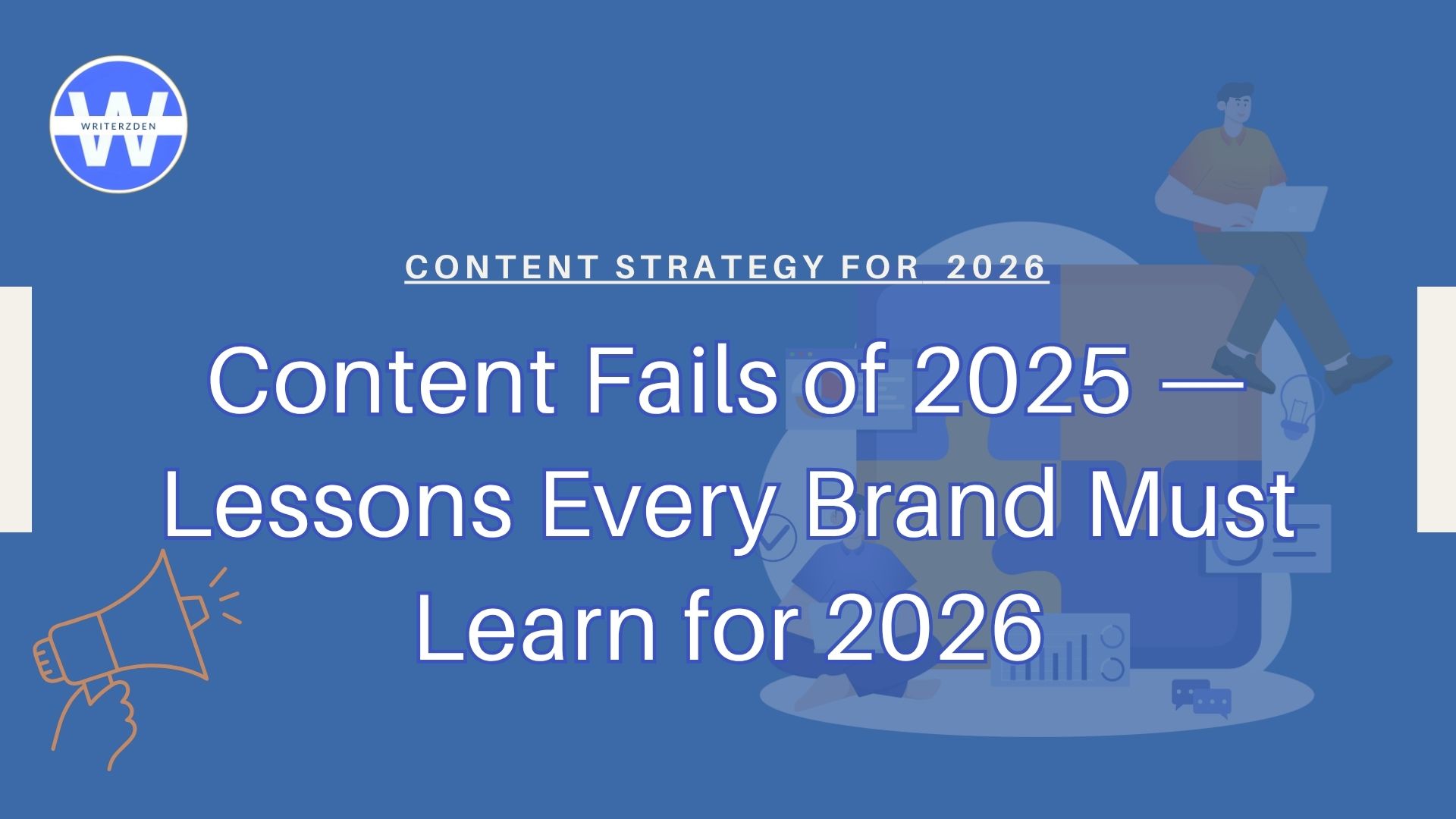Quick Summary: Most content fails because brands optimize for algorithms instead of audiences, ignore emotional decision-making, repurpose mechanically across platforms, and measure vanity metrics over business impact. Learn the seven strategic mistakes costing brands conversions—and how to fix them.
Your content team published 200 pieces this year. How many can you name that actually closed deals? This disconnect between content volume and business impact reveals strategic failures most brands refuse to acknowledge. Publishing more content in 2025 made most brands less visible, not more. While marketers chased algorithm updates and platform trends, the fundamentals of persuasive communication got buried under tactical desperation.
Nearly 70% of marketers are actively investing in content marketing, yet only 30% feel their content is effective.
– A HubSpot Study
That massive gap between investment and effectiveness isn’t about budget or team size—it’s about recurring strategic missteps that even sophisticated brands overlook. These aren’t grammar errors or formatting issues. They’re fundamental misalignments between what content teams produce and what actually moves business metrics.
Let’s examine the 7 mistakes that explain why most content underperforms, and more importantly, how to fix them.
7 Content Mistakes Draining Your Marketing ROI
Mistake #1: Writing for Algorithms Instead of Building Trust
The obsession with keyword density has morphed into something more insidious: brands now chase semantic clusters and entity optimization while forgetting that trust precedes transactions.
When content reads like it was architected for crawlers rather than crafted for humans, audiences sense the manipulation immediately.
No wonder 34% of consumers say ‘too much self-promotion’ is a major turn-off in how they perceive brands on social media.
– Social Sprout
Smart brands working with the best content writing agency in Bangalore understand that building topical authority requires depth over breadth. They create comprehensive resources that answer questions visitors haven’t yet asked, establishing expertise that naturally attracts both readers and search visibility.
The shift isn’t subtle—it’s the difference between content that converts and content that bounces.
Mistake #2: Ignoring the Emotional Architecture of Decision-Making
B2B brands remain particularly guilty of this mistake. They pump out feature lists, specifications, and jargon-heavy explanations while their prospects desperately seek reassurance, validation, and clarity.
The reality? Even complex technical products are purchased by humans experiencing doubt, ambition, and pressure from stakeholders.
The most effective content maps emotional states to information needs. A prospect researching digital marketing strategies for real estate doesn’t just need tactics—they need confidence that these tactics won’t waste their developer’s budget or damage their brand reputation.
Mistake #3: Treating Every Platform Like a Blog Post Repository
LinkedIn isn’t a blog. Instagram captions aren’t tweets.
Yet brands mechanically repurpose the same content across channels, wondering why engagement remains anemic. Each platform has distinct behavioral norms, attention spans, and content expectations that demand tailored approaches.

Professional content writing services in Bangalore recognize that platform-native content performs exponentially better than cross-posted material. Consider:
- A thread that works on Twitter needs complete reconstruction for LinkedIn
- A carousel that drives Instagram engagement would fail spectacularly on Facebook
- The format isn’t just packaging—it fundamentally shapes how audiences process information
Mistake #4: Underestimating How Rapidly Reader Expectations Evolve
What impressed audiences in 2023 now feels basic.
Surface-level listicles, generic industry observations, and regurgitated statistics signal low effort. Readers have been trained by exceptional content to expect original research, counterintuitive perspectives, and actionable specificity.
The bar hasn’t just risen—it’s stratospheric. Quality content that impacts SEO performance now requires substantial investment in:
- Proprietary data collection
- Expert interviews with industry leaders
- Unique methodologies or frameworks
Brands attempting to compete with shallow, quickly produced content find themselves invisible regardless of their optimization efforts.
Stop Making Expensive Content Mistakes
Partner with strategists who build content that converts, not just content that exists.
Mistake #5: Neglecting the Technical Foundation That Makes Content Discoverable
Even brilliant writing fails when technical elements sabotage visibility.
Common technical pitfalls:
- Missing schema markup
- Broken internal linking structures
- Poor mobile formatting
- Sluggish page speeds
These create friction that drives audiences away before they engage with a single sentence.
A strategic content writing agency in Bangalore ensures that compelling narratives sit on solid technical foundations. They understand that on-page SEO factors aren’t separate from content creation—they’re integral to ensuring valuable content reaches its intended audience.
Experienced blog writers in Bangalore know that technical excellence and compelling storytelling must work in tandem.
The truth? The most eloquent blog post delivers zero ROI if technical issues prevent discovery.
Mistake #6: Chasing Trends Without Understanding Their Strategic Fit
AI tools, interactive content, video transcripts, podcasts—brands chase every emerging format without considering whether it serves their specific audience or business objectives.
The result? Scattered efforts that dilute brand identity and exhaust resources without meaningful returns.
Strategic content operations ask different questions:
- What problems are we uniquely positioned to solve?
- Which formats do our specific audiences prefer when making decisions?
- How can we leverage our existing strengths rather than mimicking competitor approaches?
Top content writing companies help brands find this clarity before execution.
Mistake #7: Measuring Vanity Metrics While Ignoring Business Impact
Page views and time-on-site create comforting dashboards, but they rarely correlate with revenue.

Brands celebrate traffic spikes while their sales teams report that inbound leads lack qualification or urgency. The disconnect between content metrics and business outcomes has never been wider.
Sophisticated content writing services in Bangalore tie content performance directly to pipeline influence, customer acquisition costs, and lifetime value. They track:
- How specific content pieces move prospects through decision stages
- Which topics generate qualified leads
- What messaging resonates with high-value segments
Vanity metrics become secondary to business contribution.
Moving Forward with Intentional Content Strategy in 2026
The brands succeeding in 2025 share common characteristics: they create fewer pieces with greater depth, they align content with actual customer journeys, and they measure what matters for business growth.
They’ve abandoned the content volume treadmill in favor of strategic amplification of truly valuable assets.
This shift requires different partnerships and priorities. Working with specialist SEO content writers in Bangalore who understand both craft and commerce—who can balance reader psychology with technical optimization—becomes essential.
The question isn’t whether your brand can afford sophisticated content strategy. It’s whether you can afford to keep making these expensive mistakes while competitors leave you behind.
Conclusion: Your Content Strategy Deserves Better
These seven mistakes aren’t just operational inefficiencies—they’re strategic blind spots that compound over time. Every piece of algorithm-focused content, every platform-agnostic post, every vanity metric celebration reinforces habits that distance your brand from the audiences you’re trying to reach.
The encouraging reality? These patterns are fixable. Brands that acknowledge these gaps and commit to audience-first strategies see transformative results within quarters, not years. The shift begins with honest assessment: which of these mistakes is costing your brand the most right now?
If you’re ready to move beyond content that merely exists to content that converts, the path forward requires both clarity and capability. Partner with teams who’ve navigated these challenges successfully and understand that exceptional content isn’t about doing more—it’s about doing what actually matters.
FAQs
The pressure for quick SEO wins creates a dangerous cycle. Marketing teams face quarterly targets, and optimizing for algorithms feels measurable and controllable. But this short-term thinking ignores that search engines increasingly reward content that genuinely serves users. The brands breaking this pattern realize that audience trust compounds into sustainable rankings that algorithm-chasing never achieves.
Look at your analytics beyond surface metrics. Are your blog posts generating qualified leads or just traffic? Do prospects reference your content in sales conversations? Can your team articulate why you’re creating each piece beyond “it’s good for SEO”? If your sales team never shares your content or your bounce rates exceed 70%, you’re likely facing several of these issues simultaneously.
Meaningful improvement happens in phases. You’ll see engagement metrics shift within 4-6 weeks of implementing audience-first approaches. Lead quality typically improves around the 8-12 week mark as you publish enough strategic content to influence decision journeys. Full transformation—where content becomes a reliable revenue driver—usually crystallizes around 6-9 months of consistent execution.
Not entirely, but definitely recalibrate. Continue maintaining your publishing schedule with existing resources, but dedicate bandwidth to strategic planning. Audit your best and worst performers, interview customers about their decision process, and map content gaps against actual buyer questions. Many brands try to strategy-and-execute simultaneously,
This is a false dichotomy that traps many teams. Consistency doesn’t require constant novelty—it requires reliable value. Instead of publishing five mediocre pieces weekly, shift to two exceptional pieces that prospects actually save and share. Repurpose truly valuable content across formats rather than creating more shallow pieces. The brands winning attention aren’t the ones publishing most—they’re the ones creating content worth remembering.




